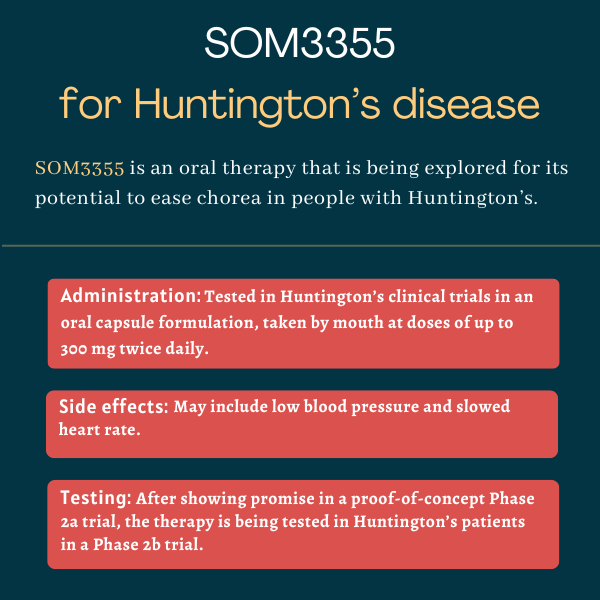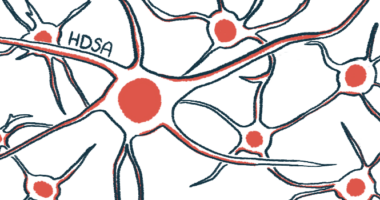SOM3355 for Huntington’s disease
Last updated June 12, 2024, by Marisa Wexler, MS

What is SOM3355 for Huntington’s disease?
SOM3355 (bevantolol hydrochloride) is an experimental oral therapy that’s being developed as a treatment for chorea related to Huntington’s disease. Chorea, referring to uncontrolled and jerky movements, is a common symptom of the neurodegenerative disease.
The treatment’s active ingredient, bevantolol hydrochloride, has been used in Asia since the 1980s to treat high blood pressure and chest pain or discomfort. It is not approved in the U.S. for any indication.
However, an artificial intelligence-based screening for drug repurposing conducted by SOM Biotech found the therapy had properties with a potential to ease chorea without causing neurological side effects. Repurposing existing medicines can shorten a treatment’s development process and lower its cost, because the compound’s safety is already established.
SOM Biotech named the drug SOM3355, and now is actively working to develop SOM3355 as a potential therapy for Huntington’s-associated chorea.
SOM3355 was designated an orphan drug by the U.S. Food and Drug Administration in 2021 for Huntington’s-associated chorea. The designation, which is meant to incentivize the development of treatments for rare disorders, provides a range of financial incentives and regulatory support.
Therapy snapshot
| Treatment name: | SOM3355 (bevantolol hydrochloride) |
| Administration: | Being tested in Huntington’s in an oral capsule formulation |
| Clinical testing: | Currently in a Phase 2b clinical trial |
How does SOM3355 work in Huntington’s disease?
A progressive neurodegenerative disease, Huntington’s is caused by mutations in the HTT gene and marked by various motor and nonmotor symptoms. Chorea, the disease’s hallmark motor symptom, is reported in about 90% of Huntington’s patients. These abnormal movements can interfere with a person’s ability to walk, swallow, and speak.
Although the exact biological mechanisms that lead to chorea in Huntington’s aren’t completely understood, available data indicate that overactive dopamine signaling plays a major role. Dopamine is a neurotransmitter, or a signaling molecule that nerve cells use to communicate with each other, involved in motor control.
Currently approved treatments for Huntington’s-related chorea, Xenazine (tetrabenazine), Austedo (deutetrabenazine), and Ingrezza (valbenazine), work by blocking the activity of a protein called vesicular monoamine transporter type 2 or VMAT2.
VMAT2 plays a central role in cellular processes that allow nerve cells to release dopamine to signal to other cells. By suppressing VMAT2, these medications are thought to reduce dopamine signaling, which ultimately helps to ease chorea. However, all three therapies are associated with an increased risk of depression and suicidal impulses, which has limited their use by Huntington’s patients.
SOM Biotech discovered that bevantolol hydrochloride, a drug with a well-established safety profile in people with certain cardiovascular problems and no known associated risk of depression or suicidal ideations, was also a VMAT2 suppressor.
While the reason behind the different neuropsychiatric effects remains unclear, bevantolol hydrochloride — now as SOM3355 — may bind to a distinct site on the VMAT2 protein, or interact with the same site but in a different way, according to SOM Biotech. In addition, the potential therapy was found to block a similar protein called VMAT1.
SOM Biotech believes that by suppressing both VMAT2 and VMAT1, SOM3355 may result in a more balanced change in dopamine signaling that preserves mental health. The therapy is expected to have similar chorea-reducing effects as other approved VMAT2 blockers, but with a lesser risk of mental health issues.
How will SOM3355 be administered in Huntington’s disease?
In Huntington’s clinical trials, SOM3355 has been administered in the form of oral capsules, at doses of 100 and 200 mg twice daily. The ongoing Phase 2b trial is testing the therapy at a maximum dose of 300 mg twice a day.
SOM3355 in Huntington’s disease clinical trials
SOM3355’s safety and efficacy has been evaluated in a proof-of-concept Phase 2a clinical trial called SOMCT02 (NCT03575676).
SOMCT02
Launched in 2018, the SOMCT02 study tested SOM3355 in 32 adults with chorea related to Huntington’s. Participants were divided into two groups. Those in group A received 100 mg of SOM335 twice daily for six weeks, then 200 mg of SOM3355 twice daily for another six weeks before returning to 100 mg of SOM3355 twice daily for six weeks, and then moving to a placebo twice daily for a final six weeks. Group B received the same treatments but with a placebo for the first six-week period instead of the last.
The study’s main goal was to determine how many patients experienced a reduction of at least two points in the Unified Huntington’s Disease Rating Scale’s total maximal chorea score (UHDRS-TMC) while on SOM3355 — at any dose — relative to the placebo period.
This scale measures chorea across seven parts of the body for a total possible score ranging from zero to 28, with higher scores reflecting more severe chorea.
At the study’s start, all participants had mild to moderate chorea symptoms, with a mean UHDRS-TMC score of 12.6 in group A and 13.14 in group B.
Results showed that more than half of these patients (57.1%) experienced such a chorea reduction during any period of SOM3355 treatment compared with the placebo period. About 1 in 10 (10.7%) experienced an improvement of at least six points with SOM3355 relative to a placebo.
A significantly greater proportion of patients also had at least a two-point drop in the UHDRS-TMC score relative to study’s start while on any dose of the therapy compared with the placebo (75.9% vs. 41.4%).
In general, scores showed a significant reduction when patients increased their SOM3355 dose from 100 mg to 200 mg and a significant increase when the dosage was again reduced to 100 mg.
The therapy was generally safe and well-tolerated, without reports of treatment-related serious side effects. Depression or suicidal ideation was reported in one patient during the study, but these problems were deemed unrelated to treatment. The single patient with suicidal thoughts had already experienced such thoughts prior to starting on SOM3355, and the treatment didn’t appear to cause a notable worsening.
Ongoing Phase 2b trial
Based on the promising data from the proof-of-concept study, SOM Biotech launched a Phase 2b trial (NCT05475483) to further assess the safety and efficacy of SOM3355 in people with Huntington’s-related chorea.
This ongoing study, called SOMCT03, enrolled 140 adults, ages 21 and older, who were randomly assigned to receive an oral capsule containing one of two doses of SOM3355 (200 or 300 mg) or a placebo twice daily for 12 weeks (about three months).
Among those in the 200 mg group, the dose is gradually increased over the first two weeks to reach the target dosage, which is maintained for eight weeks, and then gradually reduced for the remaining two weeks.
Those assigned the 300 mg dose also undergo a gradual dosage increase for the first three weeks of treatment, after which the target dose is given for seven weeks, and then tapered over the two following weeks.
The trial’s main goal is to compare UHDRS-TMC score changes after 10 weeks of treatment between patients given SOM3355 or a placebo. Secondary goals include the proportion of patients achieving a UHDRS-TMC score drop of two points or more, and changes in physician- and patient-reported global health measures, other UHDRS’ motor domains, and life quality.
The trial is expected to end by mid-2024.

Common side effects of SOM3355
In the completed, proof-of-concept Phase 2a trial, the most commonly reported adverse events in patients taking SOM3355, and at higher rates relative to the placebo, included low blood pressure and an abnormally slow heart rate, in agreement with the known effects of the therapy.
Insomnia and falls also were more commonly reported with SOM3355, but most of these events were deemed unrelated to the therapy. Insomnia is a known side effect of VMAT2 suppressors, and Huntington’s patients are at a greater risk of both insomnia and falls.
As the Phase 2a trial was a small study, more data are needed to determine all of therapy’s possible side effects.
Huntington’s Disease News is strictly a news and information website about the disease. It does not provide medical advice, diagnosis or treatment. This content is not intended to be a substitute for professional medical advice, diagnosis, or treatment. Always seek the advice of your physician or other qualified health provider with any questions you may have regarding a medical condition. Never disregard professional medical advice or delay in seeking it because of something you have read on this website.
Recent Posts
- Guest Voice: Huntington’s disease is rare, but love isn’t
- HDSA 2025: Observational studies in Huntington’s now enrolling in US
- HDSA 2025: Speakers spotlight Huntington’s clinical trials
- HDSA 2025: Speech therapy can help Huntington’s disease patients
- HDSA 2025: Early planning key for navigating care over time
- HDSA 2025: Psychedelic compound eases depression in mice
- HDSA 2025: Support can help combat Huntington’s disease stigma
- HDSA 2025: Nonprofit pushes to protect Medicaid, advance bills
- Chasing windmills: Hope in the face of Huntington’s disease
- My neuropsychiatrist shares her perspective on Huntington’s






